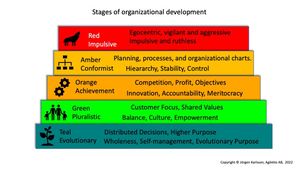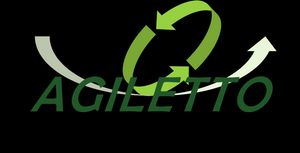Five Things You Need to Know About Teal: The Future of Organizational Development

Photo: © whyframeshot / Adobe Stock
If you're like most people in the agile community, you've been hearing a lot about Teal lately. But what is Teal, and why should you care? In this short write-up, I'll explain five things you need to know about Teal. I'll also explain why I believe that Teal represents the future of organizational development.
For me, Teal is a new way of thinking, living, growing, and exploring. Frederic Laloux explored the concept in his book Reinventing Organizations (1). Laloux describes it as "the next stage in the evolution of human consciousness" and continues by explaining how this could be applied to organizations, including structures and practices.
Laloux describes Teal as a new way of thinking about the world, one that is based on complexity, wholeness, and emergence rather than linearity and predictability. He also explains how following this model has led to "whole systems transformation" in organizations worldwide.
1. Teal is neither the goal nor the means.
Teal is not the goal. It is not a method; it is not a fixed state. For me, the Teal Paradigm, Teal, is a new way of thinking, living, growing, and exploring.
“the next stage in the evolution of human consciousness"
Think about the word next in Laloux’s definition. Nothing stops us from defining another state, stage, or paradigm after Teal. Like Ken Wilber in his work around the Integral Theory (2), several thought leaders include several stages beyond Teal, using colorful names like indigo and clear light. So Teal is definitely not a goal; it is a development stage or level. Teal is not a strategy or a gadget. It isn't even physical. It's this strong guiding light that can assist organizations, people, and societies in developing a human-centric, holistic, and purposeful culture. It is not even a strict stage, it is more like a probability wave than a step on a stairway, and you probably need a piece from several stages, and definitely do not look down on previous stages. They are vital for your development.
2. Teal has many definitions. And colors.
There is no one standard definition of Teal. Laloux defines it as the next stage of human consciousness and uses the Teal color. A stage of development. How many stages or levels are there? Various authors use different scales and definitions of these levels and rankings. But I will follow Laloux’s original definition.

Stages of organizational Development © the author
In Laloux’s model, we have different stages, or levels, of development. All stages have their own color. The first stage – Red, is a survival-based structure. The second one – Amber, is a success-based structure driven by control and power. Orange is more collaborative but still oriented towards short-term results and individualistic behavior; it represents the current state of most organizations. Green introduces values based on equality and inclusion. Here we probably find the Agile mindset and values. And finally, Teal, based on Self-Management, an Evolutionary purpose, and Wholeness.
3. Teal is based on Self-Management
All stages of organizations before Teal have relied on a hierarchical power structure, with certain people exerting authority over others. In Teal, one of three "breakthroughs" is Self-Management. The idea behind self-management is to create a system in which people can be themselves and are guided by their intrinsic motivation. And they do so without the need of being controlled or manipulated, nor with constant supervision and feedback. There are probably no managers in the sense of people managing other people. The teams are instead self-organized and – self-managed.
Teal Organizations are built on a foundation of mutual trust. Employees are seen as intelligent people that want to do good work and can be trusted to do the right thing and do it right. With that premise, very few rules and control mechanisms are needed. And employees are motivated to make amazing things happen.
As a side note: it would be interesting to find out how many rules in a typical rule-driven organization are based on the belief that we cannot trust people compared to the number of rules to help people.
4. Teal is based on Evolutionary Purpose
Organizations usually have "mission statements." These proclamations are frequently hollow; they don't really influence decision-making and, in fact, are largely unknown to workers. Instead of a common evolutionary purpose, most businesses are motivated by self-preservation, with wordings like "being the best" or "most profitable.” Or, as my very good friend Felix Albrecht put it: “the thought is there, but needs to be lived. Like a beautiful plow for the field, placed above the kitchen table in the dining room as art!”
In a Teal organization, the ego-driven desire for self-preservation is replaced by a powerful drive to do work that has real meaning and purpose. This is what Laloux calls "Evolutionary Purpose." The evolutionary purpose is based on the idea that we are all here to serve a greater good; it is about using our unique talents and gifts to contribute to something larger than ourselves.
5. Teal is about Wholeness - the Holistic view
A Holistic view is when we understand the greater whole. Teal organizations, and the people working in them, see themselves as part of a larger system, with the Evolutionary Purpose discussed above, but also part of a much bigger system.
We can think about three different kinds of wholeness; Wholeness for Individuals: physical, emotional, social, and spiritual health. Wholeness for Organisations: wholeness for the organization as a living system, an organism in its own right. Wholeness in the World: the organization’s role in creating a more wholesome world.
When we start to think about these three different aspects of wholeness, it can help us understand how our work impacts not just ourselves and those around us but also the wider world. It can help us see that our work is part of something greater. That our work affects the planet and the society.
Conclusion
Teal might be a complex and challenging subject at the beginning. But based on the above five things, I hope you understood the basics of Teal and what many think is the future of organizing. I believe that we should all continue looking into and learning more about it. It can help us create healthy, balanced, holistic serving organizations. Happier people and a better world. What could be better than that? What are your thoughts?
References and further reading
1. Laloux, Frederic. Reinventing Organizations. 2014.
2. Wilber, Ken. Introduction to Integral Theory and Practice: IOS Basic and the AQAL map. 2005.
This article was originally published at Medium, Feb 2022
Last updated May 27, 2025
